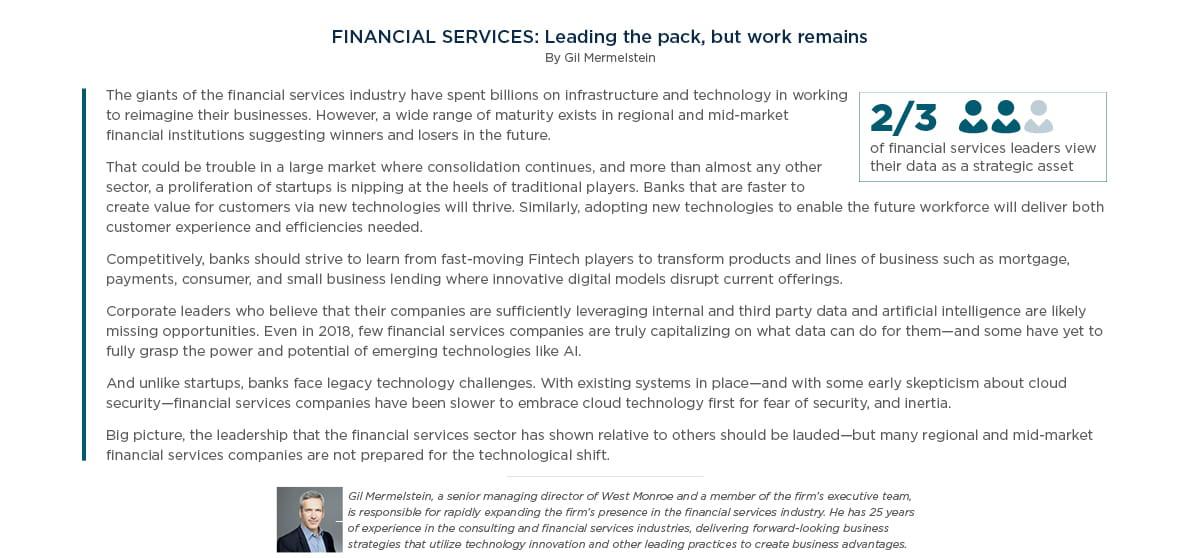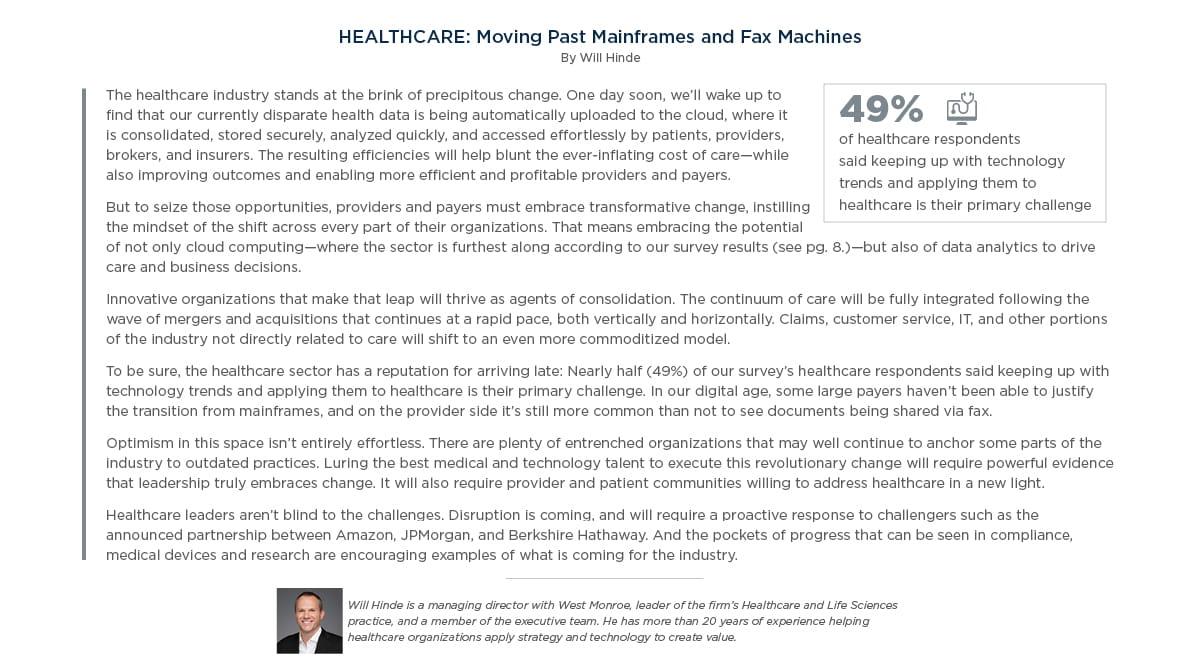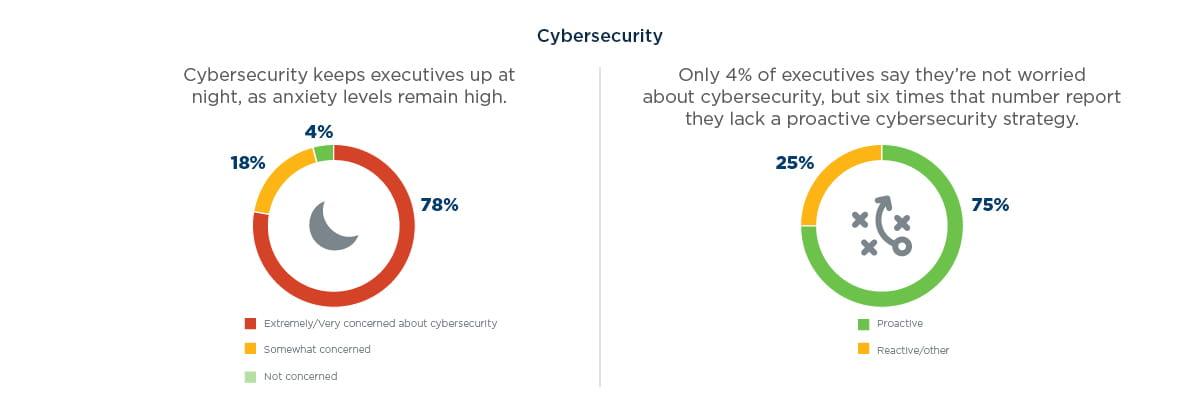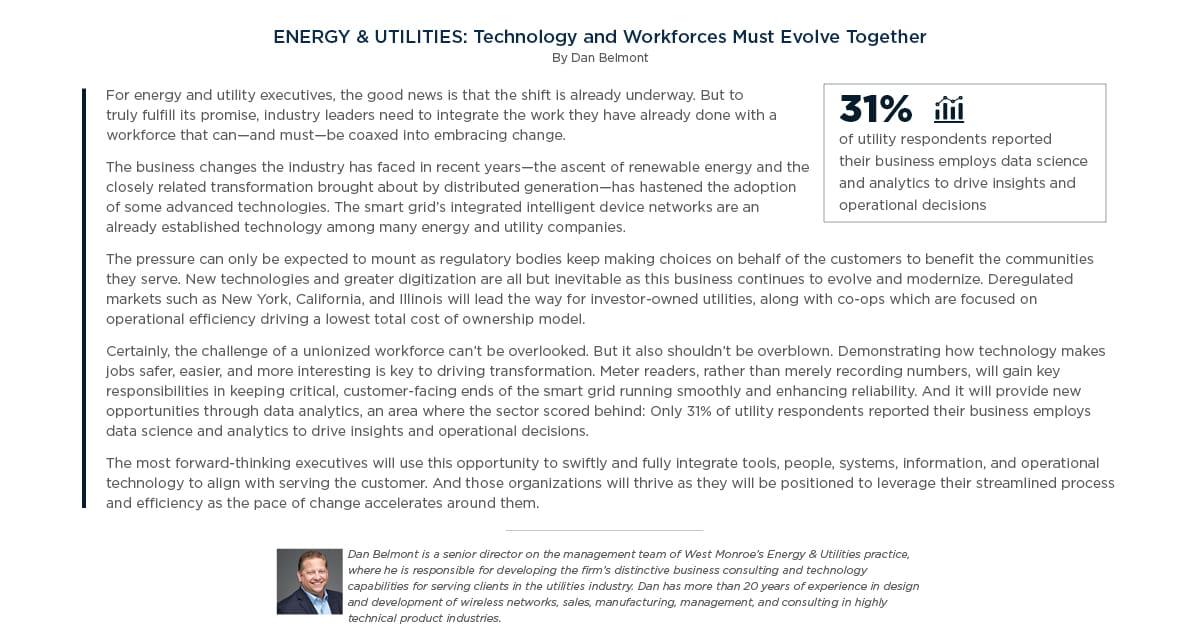Research
Technology is Transforming Everything: Businesses Struggle To Change With It
West Monroe surveyed 300 business and technology leaders to identify and quantify the gaps their businesses must close in order to survive, and thrive, in the digital age
March 28, 2018
In late 2017, West Monroe surveyed 300 company executives on their approach to technology and how prepared they are for the “shift.” Here is what leaders from three sectors of the economy— healthcare, financial services, and energy and utilities—reported about their organizations.
Disruption is on the radar—but the outlook is too rosy
94 percent of survey respondents said disruptive technologies will create business opportunities in the coming years, while 42 percent of respondents didn’t classify disruptive technologies as threats. “To capitalize on opportunity, this is the time for action,” Layok says. “The winners and losers are defined more clearly in this age, so you cannot afford to be complacent.”Competitive pressures are not top-of-mind but should be
68 percent do not believe competitors are successfully leveraging their own data. This is an instinct worth trusting— but it’s only effective if it’s combined with action to propel the organization’s transformation. Only one-third of respondents have technology initiatives in flight to augment their own customer experience. Predictive reports rank last on the list of reports, with analysis and “trending” data more popular ways of using data. “Everything feeds off data from previous years,” said one executive respondent.Cybersecurity is keeping leaders up at night
Anxiety over cybersecurity remains high, with only 4 percent of respondents not worried about it. But they can’t quite pinpoint the root of their fears, with most feeling confident about the security of their data. Many who worry also report they lack a proactive cybersecurity strategy.Each sector has different strengths
Clearly driven by their respective competitive and operational landscape. Healthcare was the farthest along in cloud adoption; financial services organizations were far more likely to consider their data a strategic asset; and utilities can detect customer patterns quicker than the other sectors. However, no sector displayed widespread adoption of the kind of holistic transformation called for by the shift.
Introduction
The world is shifting around us. Technology presents every organization with unprecedented opportunities to elevate performance, scale, and market impact. Those same technologies also present a grave threat to those who fail to adapt quickly.
Customers are dictating the terms of relationships. Reports are being replaced by predictions. Data is both created and required at every interaction, in every moment. Business and information technology functions can no longer thrive separately but must evolve to operate in concert. Meanwhile, security looms as an Achilles’ heel that threatens to upend organizations at any moment.
Many companies think they are prepared for what’s ahead. But our survey of 300 company executives found that few are.
“Investments in technology alone will not automatically create business opportunity,” says Greg Layok, managing director of the Technology practice at West Monroe. “You have to create a culture of experimentation where failing fast is encouraged and the business and technology work as one team. Without this, you will limit innovation, move slowly, and not take full advantage of the shift. It is important to consider your actions in the context of your competitors and industry to take a deliberate approach,” Layok says. “Nobody’s going to get it overnight. It’s a journey.”
The survey results show that company leaders are overwhelmed by the volume of data and technologies their companies have access to—and what to do with it. The good news is that it’s not too late to take a hard look at your organization to see where you can most quickly and forcefully drive better decisions. The stakes are high, and you shouldn’t only focus on your peers’ best practices, but also consider new and unanticipated market entrants. Each day we have digital leaders—like Amazon—entering and altering existing industries.
Introduction
The world is shifting around us. Technology presents every organization with unprecedented opportunities to elevate performance, scale, and market impact. Those same technologies also present a grave threat to those who fail to adapt quickly.
Customers are dictating the terms of relationships. Reports are being replaced by predictions. Data is both created and required at every interaction, in every moment. Business and information technology functions can no longer thrive separately but must evolve to operate in concert. Meanwhile, security looms as an Achilles’ heel that threatens to upend organizations at any moment.
Many companies think they are prepared for what’s ahead. But our survey of 300 company executives found that few are.
“Investments in technology alone will not automatically create business opportunity,” says Greg Layok, managing director of the Technology practice at West Monroe. “You have to create a culture of experimentation where failing fast is encouraged and the business and technology work as one team. Without this, you will limit innovation, move slowly, and not take full advantage of the shift. It is important to consider your actions in the context of your competitors and industry to take a deliberate approach,” Layok says. “Nobody’s going to get it overnight. It’s a journey.”
The survey results show that company leaders are overwhelmed by the volume of data and technologies their companies have access to—and what to do with it. The good news is that it’s not too late to take a hard look at your organization to see where you can most quickly and forcefully drive better decisions. The stakes are high, and you shouldn’t only focus on your peers’ best practices, but also consider new and unanticipated market entrants. Each day we have digital leaders—like Amazon—entering and altering existing industries.
Chapter 1: Data is an asset – when put into action
All companies have data, but collecting it is merely the first step toward extracting its value.
While most companies are already maintaining data, many still face a long road ahead. Forty-eight percent of respondents said their organizations don’t view data as a strategic asset, and only about a third said their organizations are employing data science or analytics to drive insights or operational decisions. While one respondent called data “the core of everything we do,” another said, “We do a lot of data mining but take very little action as a result.”
“Data is only valuable when it is surfaced to create actionable insights,” says Layok. “You have to use the information to understand your customers better and better serve their needs. Let it inform your product development process. And create feedback loops to nurture your data quality and collection.”
The vast majority of survey participants reported average or better data quality, but again, most aren’t doing much with it. While 90 percent of respondents said their own data was at least of average quality and 94 percent of respondents can access data within a day or less, there are still 76 percent who said they can’t detect customer patterns immediately or in real time, and more than half of leaders who took our survey don’t feel they use this resource fully.
A leader’s view of their data may be influenced by the types of reporting they receive. About 3 in 4 (73 percent) focus on analysis of past data, 55 percent receive real-time alerts, 50 percent look at trending data, and 38 percent leverage predictive reporting. While past data can be an indication of future behavior, that is not always the case and something leaders are keenly aware of. Having the right combination of all types of reporting is important—but what’s more important is using the data to make decisions. Too much data without the proper context or prompts for decision-making can do more harm than good, leading people to tune out the noise.
“Having access to data isn’t the same thing as driving business value,” Layok says. “Reports that explain what happened yesterday are table stakes for businesses today. Embracing predictive modeling and learning algorithms to optimize business results are required to use your data to drive competitive differentiation.”
Industry comparison: Strengths and weaknesses – but no transformative leader
Each sector we surveyed had different technology and information strengths, clearly driven by each’s competitive and operational landscape. But no sector displayed widespread adoption of the kind of holistic transformation called for by the shift.
While financial services leaders were likely to view the information they collect as a strategic resource, healthcare companies emerged as the most mature adopters of cloud- based systems. Meanwhile, the energy and utility industry is amid a digital revolution that has provoked widespread use of the networked devices known as the Internet of Things.

Financial Services: Data rules, but cloud lags
Significantly, two-thirds of financial services said they use data strategically, a sizable advantage over the other sectors. Regulatory requirements, breakthroughs in fin tech, an industry wide drive to get closer to customers, and a wave of startup competitors have pushed established players to leverage their data early—cross-selling customers on risk or fraud detection products by recognizing patterns in behavior and analyzing customer data.
Financial services respondents were also most likely to see their competitors using disruptive technologies to drive business value (81 percent) and to perceive themselves as prepared or very prepared to respond to external threats (73 percent).
Respondents from this industry confirm that it lags in the adoption of cloud technologies—only 18 percent house more than half of their data in the cloud—and instead have invested heavily in their own infrastructures. But we have seen these companies use the cloud to improve their speed to market, working for every incremental advantage against competitors.

Healthcare: Leveraging the cloud
Cloud adoption was most robust in the healthcare space, where organizations—notably providers—typically don’t have large IT departments. Respondents in that sector said the cloud provided a way to reduce risks and lower costs.
Privacy regulations around information handled by healthcare companies are a profound motivation, as they face daunting consequences, including criminal liability, for data breaches. In an industry that has tended to lag in technology adoption, the next step is to leverage the cloud for interoperability and care coordination. In other words, use the cloud to facilitate secure and efficient communication among patients, doctors, hospitals, and payers. The resulting efficiencies will help ease cost of care and improve patient outcomes.

Digital arrives for utilities – with some caveats
A host of factors are driving the energy and utilities market to digitize their infrastructure and operations— customer expectations, aging technology, and regulatory requirements to name a few. While the industry is readying for the shift, certain realities are holding it back.
One of those realities is data, as 70 percent of utilities still rely on IT to handle data governance—a higher rate than financial services organizations and almost twice as much as healthcare companies. Another reality is cybersecurity concerns, with twice as many utility leaders saying their cybersecurity strategy is “reactive” when compared to financial services leaders. All this said, utility leaders are confident in the accuracy of their data and can detect customer patterns quicker than the other sectors.


Chapter 2: Leaders are fairly confident their systems are secure, but cybersecurity still keeps them up at night
Almost all respondents (96 percent) across all three industries reported concern about data security. But more than a quarter rated their critical systems and data as just “moderately secure,” or worse. And still, more than 70 percent of organizations said they feel comfortable with their preparedness for a cyberattack.
“Organizations constantly focus on security as an end point—something to achieve to help them sleep better at night, but there is no end. It is an evolving goal that requires appropriate investment,” says Sean Curran, Senior Director in West Monroe’s Technology practice. “If it weren’t, we wouldn’t continue to see breaches at high profile organizations who have invested far more money than smaller players ever could.”
Reconciling how safe leaders feel with how secure their businesses actually are takes more than a set of tools or certifications. This isn’t trivial for any company, especially for those in the surveyed industries: They hold precious personal and financial information and control key infrastructure subject to routine attack.

“People are worried, so they look for things like certifications and the latest tools to make themselves feel better,” Curran says. “But businesses need to think about the entire security ecosystem—not only processes and technology, but also people—to be truly secure. Smart business leaders understand a cyberattack isn’t a possibility, it’s an inevitability. And yet, even in a climate of awareness about the threats posed by cybercrime, businesses aren’t doing enough to prepare for these incidents.”
Having a well-protected information supply chain with the requisite safeguards is vital. What happens when attackers breach these defenses? How do companies handle an incident and its fallout? When every second counts, previous preparation increases the speed at which organizations can respond, avoiding hastily made decisions because the pros and cons have already been weighed. Preparation also cuts through the paralysis that can come with such an event.
At the end of the day, cybersecurity should be top of mind to keep your organization on its toes. But ask yourself, is it top of mind because you don’t have a handle on your biggest threats? Or that you’re ill-equipped for an attack? Or perhaps you do have a handle on your strategy, but it’s just not the right one? Pinpoint the root of your worry to make sure it’s not an indication of unpreparedness.


Chapter 3: Serve your customers by keeping your own systems updated
At West Monroe, we beat the drum about how the “shift” is just as much about people and processes as it is about technology. But technology is an important part of keeping pace with the shift.
In this part of the equation, neglecting updates to core systems is putting a majority of survey respondents at risk of falling behind the technology curve. Only a quarter of respondents said they updated their core systems to provide additional business functionality monthly or weekly. A third of respondents make updates quarterly, 28 percent update annually, and 15 percent said they make updates only once every few years.
Companies that rarely evaluate their systems are all but ignoring a significant blind spot, while leaders who take on the mindset of a software executive—and frequently update and upgrade systems—give their organizations a vastly richer capability to improve the experience of their employees, customers, and partners.
“Companies are missing opportunities because they are not asking the hard questions that help them derive value from technology investments or know when to make new ones,” Layok says.
Chapter 4: What to do about it
Each industry, like each organization, leads in some areas and lags in others, based on the competitive and operational pressures it faces. To truly lead, companies must look beyond survival to understand and integrate the wide breadth of tools available.
In 2017, we partnered with over 100 clients to help them Master the Shift. Through our client engagements we identified 6 dimensions of the shift. All with different impacts, but equally important to a company’s success.
Our survey clearly showed that companies fully appreciate the magnitude of the changes already underway and are hungry for practical answers about how to grapple with the change and thrive through it. What follows should be viewed as foundational for smart businesses as they ready for the shift.

Build a modern platform
Organizations with complex infrastructures need clarity. Maximize the value of existing infrastructure by working with an experienced partner to forge an efficient and prudent cloud migration strategy. The result is a business-enabling modern platform that provides the agility and responsiveness necessary to quickly bring new products, services, and capabilities to market
What this could look like:
- For a bank, prioritize a cloud migration to gain more engaged customers and outperform across key metrics, including the efficiency ratio.
- Re-platform to a PCI-compliant Microsoft Azure cloud deployment.
Tap into actionable data
Companies must quickly adapt to the rapidly evolving landscape of advanced analytics tools and capabilities. And they must translate complex business requirements into practical technology-based data platforms that suit their businesses. To do this, their leaders need to seek expert guidance on where to start, how to assess value, and which metrics are most important. From there, companies can make data-driven decisions you didn’t believe were possible.
What this could look like:
- For a hospital network, this could mean building a series of interactive dashboards that allow providers to better understand patients and make more informed decisions to improve quality of care.
- For a retailer, this could mean analyzing online behavior to identify the root cause of abandonment rates.
Drive powerful engagement
If you aren’t drawing actionable insights from data across your organization, all the technology in the world is unlikely to save you. The survey shows that executives understand the gap between using technology and data analytics, but the way to close that gap is to change the organization’s behaviors, people, processes, and mindset about data and decision- making.
The leaders of tomorrow must engage customers, employees, business partners, and devices (“things”) in a powerful, differentiated way that drives value and lifts business metrics, even in a mobile environment. But those leaders need solutions to do two things very well: build effective interfaces that deliver a compelling experience and establish analytics and reporting capabilities that allow them to understand and act on engagement.
What this could look like:
- In healthcare, create a mobile app for patients to communicate directly with providers.
- Build digital-first platforms for employees that increases collaboration, connectivity, and efficiency.
Influence customer behavior
Too many companies are passively observing their customers and failing to turn those insights into action: 73 percent of survey respondents say they proactively seek out customer patterns, but only a third have instituted technology initiatives to augment their customer experience.
It’s important to apply data science and advanced machine learning techniques to help understand, predict, and influence customer behavior. This starts with the ability to access data more efficiently. From there, companies need capabilities for analyzing customer data continuously that also use data to create effective, segment-specific strategies that improve customer interactions at every step of the relationship.
What this could look like:
- For a bank, this could mean creating personalized offerings in a real-time mobile offer framework to gain a finer understanding of customer preferences.
- Create more sales opportunities by looking at purchase history to recommend new potential products a customer is likely to buy.
Secure the business
Business leaders are rightfully anxious about cybersecurity—even though most believe their own data is secure. But here again, we see far too many organizations relying on point solutions and certifications to protect their digital assets. True cybersecurity requires a far more holistic approach—fully integrating security into business processes.
The most effective security strategy is preventative, not reactionary. To achieve that, companies need to focus not simply on compliance but on making sure they have the right security investments, programs, and processes for managing the threat landscape and protecting their businesses over time, not just at a particular point in time. As we’ve noted, purchasing tools and gaining certifications is simply insufficient. True security requires organization-wide change in behaviors, processes, and policies.
What this could look like:
- Conduct an assessment on whether your company is compliant with new GDPR regulation. (Hint: All businesses must follow this rule; not just those in Europe.)
- Run tabletop exercises with a third party to validate that your cyberattack response plan considers all actions and activities that need to occur during a breach.
Run seamless operations
Strong, efficiently run and maintained core systems are the foundation for growth and innovation. Organizations need the depth and breadth necessary to run 24x7 core operations—not to mention the ability to draw on key business, industry, and technical expertise. It’s important to master the fundamentals in order to master the shift.
What this could look like:
- Outsource the 24/7 needs that your mobile or digital workforce needs so you can focus on critical business issues.
- Find a partner to deliver your uptime, security, and monitoring.
Conclusion
If only about half of companies see data as a strategic asset, then all companies have a profound opportunity to leap ahead. It won’t happen overnight; transformation is a journey, though one that successful companies poised to thrive in the future have already begun. The further you progress, the more adaptable you will become to change—which will only happen faster. The shift is here. Build for it.
Survey methodology
